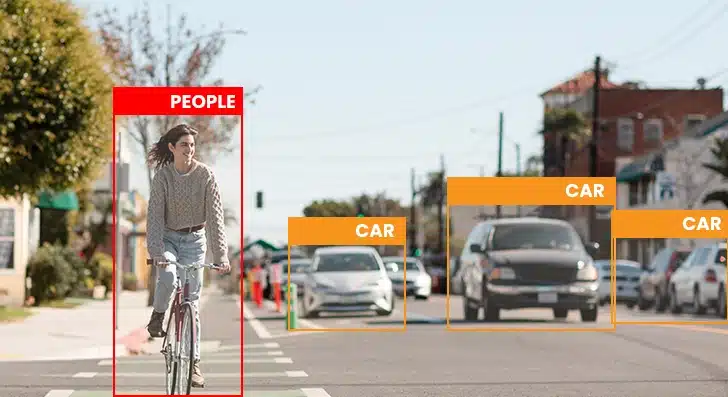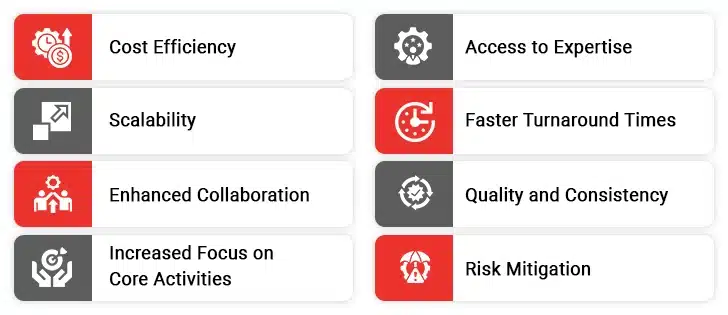Image annotation is changing the way businesses operate, making everything from automation to customer experience smarter and more efficient. But very few know exactly what it is.
At its core, image annotation is the process of labeling images so that AI and machine learning models can recognize patterns, identify objects, and make informed decisions based on visual data. Think of it as teaching computers to “see” the way humans do. Without accurately labeled images, AI-driven applications—like self-driving cars, facial recognition, and medical imaging—wouldn’t function effectively.

From healthcare and ecommerce to automotive and security, industries are leveraging image annotation to enhance their services, optimize workflows, and deliver smarter, more intuitive solutions. However, the process can be time-consuming and resource-intensive, which is why outsourcing image annotation is becoming an increasingly popular strategy.
In this post, we’ll explore real-world applications of image annotation across industries. We’ll also dive into the key benefits of outsourcing this as a service. Let’s get started!
Popular Use Cases of Image Annotation Across Industries
These real-life use cases depict how image annotation helps businesses in making smart decisions.
1. Autonomous Driving
Image annotation plays a crucial role in self-driving cars. These cars use advanced computer vision systems to drive safely on the roads. Annotated images of roads, traffic signs, people, and obstacles are used to train machine learning models. For example, images are marked with boxes around different objects, helping the car’s system recognize and respond to its surroundings. This training allows the vehicle to make quick decisions while driving. By using annotated data, manufacturers make self-driving technology safer and more reliable.
2. Retail and Ecommerce
In retail, image annotation helps improve product management and customer experience. Retailers use annotated images to sort products by features like color, size, and style. For example, a clothing store may label images of shirts with tags showing their colors and designs. This makes it easier for customers to search for specific items online using visual search tools. Additionally, annotated images help manage inventory by tracking product availability in stores. By improving product visibility and searchability, image annotation leads to better customer satisfaction and increased sales.
3. Healthcare
In healthcare, image annotation is crucial for examining medical images. Annotated images help AI systems identify diseases and problems more accurately. For example, doctors can label parts of an X-ray that show signs of tumors or fractures. This labeled data trains AI models to recognize similar patterns in new images, allowing for early detection of issues like cancer or heart disease. By improving accuracy and reducing mistakes, image annotation helps doctors provide better care and make quick treatment decisions.
Building An Ethical AI in Healthcare: The Critical Role of Data Annotation Services
4. Security and Surveillance
Image annotation is important for security and surveillance systems. These systems use annotated images to train AI models that recognize suspicious activities or unauthorized people in monitored areas. For instance, security cameras capture video that is then annotated with information about people or objects of interest. These annotations help the AI system learn patterns associated with potential threats or criminal behavior. By improving the accuracy of threat detection systems through image annotation, organizations enhance safety measures in public spaces and private properties.
5. Fashion
The fashion industry utilizes image annotation for various purposes including trend analysis and inventory management. Designers can annotate images of clothing items with details about styles, fabrics, and colors to track trends over time effectively. Retailers also use this data to categorize products better online based on customer preferences observed through visual searches. By utilizing image annotations in fashion marketing strategies, companies can enhance their offerings while staying aligned with current trends.
6. Education
In education, image annotation serves various purposes that enhance learning experiences for students. One significant application is interactive learning materials. Educators can annotate images in textbooks or online resources to highlight important concepts or details. This visual aid helps students understand complex topics more easily.
7. Manufacturing
In manufacturing settings, image annotation is used for defect detection, which helps improve quality and efficiency. In this process, images of products are labeled to identify any defects during production. By using AI models trained on these annotated images, manufacturers can quickly spot issues like scratches or misalignments. This ensures only high-quality products reach customers, reducing returns and complaints.
8. Sports Analytics
In sports analytics, image annotation is used to analyze player movements during games. Coaches and analysts annotate video footage with labels that track player positions, actions, and strategies on the field. For example, they may label instances when a player makes a successful pass or scores a goal. This data helps teams evaluate performance and develop better game strategies based on insights gained from analyzing player behavior over time. By utilizing annotated video data, teams can improve training methods and increase their chances of success in competitions.
9. Insurance
In the insurance sector, image annotation is used for assessing damages in claims processing. When policyholders submit claims for vehicle accidents or property damage, insurance companies analyze photos taken at the scene using annotated data that highlights areas of damage or risk factors involved in incidents. Annotated images help adjusters evaluate claims more accurately by providing clear visual evidence of damages that need assessment or repair costs estimation. This leads to quicker claim resolutions and improved customer satisfaction.
10. Urban Planning
Image annotation supports urban planning efforts by helping planners visualize land use zones within cities through labeled satellite imagery or maps showing different areas designated for residential, commercial, or recreational purposes. Annotated images allow planners to assess development needs accurately while ensuring compliance with zoning regulations effectively over time as cities evolve rapidly due to population growth or infrastructure changes.
11. Gaming
Image annotation is crucial for creating engaging experiences. The gaming industry uses image annotation for character recognition within games allowing developers to create realistic environments. By labeling images of characters and their movements, developers can train AI models to recognize player actions in real-time. This makes games more interactive and responsive to players’ input.
12. Social Media
Image annotation plays a significant role in enhancing user experience on social media platforms through user tagging. When users upload photos, image annotation helps identify and tag individuals in the images. This makes it easy for friends and family to interact with each other’s posts. It also allows users to quickly find photos they are in. This encourages a sense of community and engagement.
How Outsourcing Image Annotation Helps Businesses Unlock Complex Visual Data
Advantages of Outsourcing Image Annotation Services

Listed below are the significant benefits of outsourcing image annotation services.
I. Cost Efficiency
Outsourcing image annotation helps businesses save significant amounts of money. When companies choose to manage annotation on their own, they must spend a lot for hiring staff. By outsourcing, companies may eliminate overhead costs and pay only for the services they need. This flexibility helps businesses allocate their budgets better. Additionally, outsourcing partners usually have established processes that make the annotation work faster and cheaper. Overall, outsourcing image annotation helps companies save money while still getting quality work from skilled professionals.
II. Access to Expertise
When businesses outsource image annotation, they get to work with skilled professionals. These experts have experience with different types of image annotation, ensuring that the work is accurate and meets industry standards. For example, they can handle complex tasks like semantic segmentation with ease. By using this expertise, companies improve the quality of their annotated data, which is important for training AI models. Outsourcing partners also stay updated on the latest trends and technologies in image annotation. This provides businesses access to new solutions that might not be available in-house. This specific knowledge improves the success of AI and machine learning projects.
III. Scalability
Image annotation outsourcing provides businesses with the flexibility to quickly adjust their efforts based on project needs. When companies handle annotation internally, they might find it hard to adjust resources during peak times or tight deadlines. Hiring and training new staff takes time and may not work for short-term projects. In contrast, outsourcing partners can quickly increase their teams to handle more work or specific project needs. This scalability allows companies to respond quickly to changing demands without losing quality or efficiency. Whether a business needs multiple images annotated quickly or ongoing help for smaller projects, outsourcing ensures that resources are available when needed.
IV. Faster Turnaround Times
Outsourcing image annotation means faster project completions. Specialized service providers usually have teams focused only on annotation tasks, allowing them to finish work faster than an in-house team that has many responsibilities. These external teams often use advanced tools that make the annotation process quicker. As a result, companies speed up their project timelines and launch products or services faster. This speed is important in competitive industries where being first can make a big difference in success.
V. Enhanced Collaboration
When companies outsource image annotation tasks, they create opportunities for better teamwork between different teams across departments within an organization or even with external partners involved in related projects. Collaborative platforms used by many outsourcing image annotation services providers make it easy to communicate and share feedback, ensuring everyone stays aligned throughout project lifecycles and improving results significantly.
VI. Quality and Consistency
Outsourcing image annotation helps ensure high-quality and consistent results across projects. Professional service providers use strict quality control measures to keep their annotations accurate and reliable. They have guidelines that annotators follow closely to ensure uniformity in labeling images. This consistency is important for training AI models since differences in data quality leads to poor model performance. By relying on experienced annotators, businesses feel confident that their annotated data will meet the necessary standards.
VII. Increased Focus on Core Activities
By outsourcing image annotation tasks, businesses may focus on their core activities instead of getting bogged down on annotation work. Internal teams can put their efforts into key functions that help the business grow and succeed. When employees are not distracted by annotation tasks, they can work more efficiently on projects that align with the company’s goals. This focus on core activities improves overall productivity and performance within the organization.
VIII. Risk Mitigation
Image annotation outsourcing helps reduce risks related to mistakes or inconsistencies in annotated data. Professional service providers usually have quality assurance measures that lower the chance of errors during the annotation process. They also have experience handling sensitive data and ensuring compliance with privacy regulations. This helps minimize potential risks for businesses. By working with reliable outsourcing firms, companies focus on their main operations while knowing that their image annotation needs are managed by experts who prioritize data security and quality.
IX. Access to Advanced Technologies
Outsourcing image annotation allows businesses to access advanced tools that may not be available in-house. Specialized service providers often invest in top software designed for efficient image labeling and analysis. These tools automate parts of the annotation process or improve accuracy with features like AI-assisted labeling. By using these advanced technologies through outsourcing partners, companies work more efficiently while ensuring high-quality image annotations.
X. Flexibility in Project Management
Outsourcing annotation provides flexibility in managing projects according to specific needs and timelines. Companies may easily adjust their requirements based on changing priorities without worrying about staffing issues that come with an internal team. This flexibility allows organizations to take on new projects while maintaining high-quality standards.
Optimize Your AI Projects with Accurate Image Annotation!
How to Make the Right Choice: In-House vs. Outsourced Image Annotation
| Comparison Factor | Outsourcing | In-House Teams |
|---|---|---|
| Cost | Usually costs lower since companies need to pay only for services used | Often costs higher due to salaries and infrastructure |
| Expertise | Access to skilled professionals with experience | May lack specialized skills and require training |
| Scalability | Easy to scale up or down based on project needs | May struggle to adjust to changing workloads |
| Time Efficiency | Faster setup and deployment due to established processes | Takes longer to train staff and set up systems |
| Quality Control | Quality may vary; requires oversight to ensure accuracy | Direct control over quality, but may face consistency issues |
| Flexibility | Flexible in adapting to different project sizes and requirements | Less flexible; may need more resources for larger projects |
| Focus on Core Activities | Frees up internal teams to focus on important tasks | Internal teams may be distracted by annotation work |
| Data Security | Risk of sharing sensitive data with third parties, unless reliable providers are chosen | Better control over data security as everything is handled internally |
| Infrastructure Needs | No need for additional tools or facilities; outsourcing partners provide them | Requires investment in tools and infrastructure for data annotation |
| Long-Term Commitment | Often a short-term solution for specific projects | More suitable for ongoing, long-term data annotation needs |
Summing Up
As technology continues to advance, the need for accurate and reliable image annotation will grow. Companies that invest in this process will be better positioned to use data for decision-making and improve their products and services. Overall, image annotation is more than just a technical task; it plays a crucial role in shaping the future of various industries.





